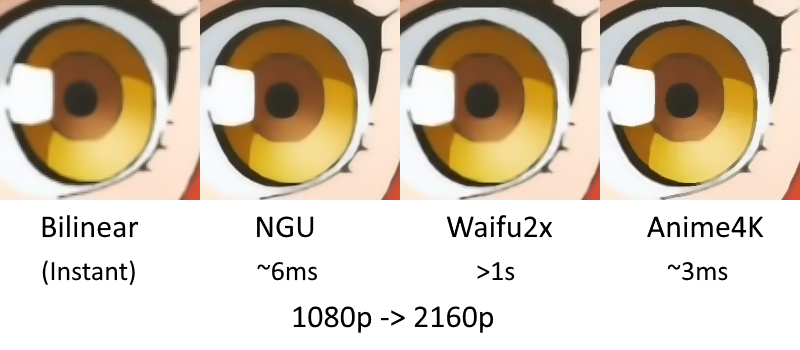Anime4K is a state-of-the-art*, open-source, high-quality real-time anime upscaling algorithm that can be implemented in any programming language.
*State of the art as of August 2019 in the real-time anime 4K upscaling category, the fastest at acheiving reasonable quality. We do not claim this is a superior quality general purpose SISR algorithm compared to machine learning approaches.
Disclaimer: All art assets used are for demonstration and educational purposes. All rights are reserved to their original owners. If you (as a person or a company) own the art and do not wish it to be associated with this project, please contact us at [email protected] and we will gladly take it down.
Reduced texture loss, aliasing and banding in Anime4K v1.0 RC at the cost of performance. It now takes 6ms. +2ms for line detection and +1ms for line targeted FXAA.
What's new:
- A line detection algorithm.
- Gradient maximization is only applied near lines using the line detector, instead of indiscriminately affecting the entire image. This has the effect of ignoring textures and out of focus elements.
- Finally, one iteration of targeted FXAA is applied on the lines using the line detector to reduce aliasing.
This implementation is only for Windows.
Note for developers: For performance, the HLSL shaders use the Alpha channel to store the gradient, you might need to make a backup of the the alpha channel before applying these shaders and restore it after if your rendering engine uses the alpha channel for other purposes. (In MPC-BE's case, it gets ignored.)
This implementation is cross platform.
Note for developers: For performance, the GLSL shaders use the POSTKERNEL texture to store the gradient, you might need to make a backup of the the POSTKERNEL texture before applying these shaders and restore it after if your other shaders or rendering engine uses the POSTKERNEL texture for other purposes. (In MPV's case, it gets ignored.)
Click on the link above to read Java version installation and usage instructions.
B. Peng
August 2019
Ad perpetuam memoriam of all who perished in the Kyoto Animation arson attack.
- Abstract
- Introduction
- Proposed Method
- Results and Upscale Examples
- Discussion
- Analysis and Comparison to Other Algorithms
We present a state-of-the-art high-quality real-time SISR algorithm designed to work with japanese animation and cartoons that is extremely fast (~3ms with Vega 64 GPU), temporally coherent, simple to implement (~100 lines of code), yet very effective. We find it surprising that this method is not currently used 'en masse', since the intuition leading us to this algorithm is very straightforward.
Remarkably, the proposed method does not use any machine-learning or statistical approach, and is tailored to content that puts importance to well defined lines/edges while tolerates a sacrifice of the finer textures. The proposed algorithm can be quickly described as an iterative algorithm that treats color information as a heightmap and 'pushes' pixels towards probable edges using gradient-ascent. This is very likely what learning-based approaches are already doing under the hood (eg. VDSR[1], waifu2x[2]).
waifu2x is too slow for real time applications.
NGU is proprietary, this algorithm is licensed under MIT.
Since it performs poorly (perceptually, for anime) compared to other algorithms, it was left out of our visual comparisons.
Note: FSRCNNX was not specifically trained/designed for anime. It is however a good general-purpose SISR algorithm for video.
There are no ground truths of 4K anime.
Comparing PSNR/SSIM on 480p->720p upscales does not prove and is not a good indicator of 1080p->2160p upscaling quality. (Eg. poor performance of waifu2x on 1080p anime) 480p anime images have a lot of high frequency information (lines might be thinner than 1 pixel), while 1080p anime images have a lot of redundant information. 1080p->2160p upscaling on anime is thus objectively easier than 480p->720p.
Surely some people like sharper edges, some like softer ones. Do try it yourself on a few anime before reaching a definite conclusion. People tend to prefer sharper edges. Also, seeing the comparisons on a 1080p screen is not representative of the final results on a 4K screen, the pixel density and sharpness of the final image is simply not comparable.






